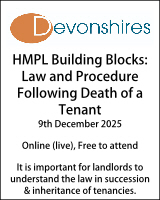Re-evaluating Birmingham v Lee
Karamjit Singh highlights the importance of understanding the continued relevance of the 2008 Court of Appeal ruling in Birmingham v Lee to housing disrepair litigation.
- Details
At the heart of Bleak House, Charles Dickens delivers a scathing critique of a legal system so bogged down in endless procedures and paperwork that it ends up ruining the very lives it was designed to protect. Central to this narrative is the interminable lawsuit of Jarndyce v. Jarndyce, a case that devours generations of family wealth in legal fees and drags on so long that it ultimately outlasts its litigants. The case evaporates into nothing, leaving only despair and a hollow sense of loss in its wake.
While Bleak House remains a timeless critique of a dysfunctional legal system, the modern-day equivalent can sometimes be found in housing disrepair litigation, where the question of costs can lead to frustration for both claimants and defendants.
In particular, the case of Birmingham City Council v. Lee [2008] EWCA Civ 891 remains a point of confusion for many, despite its long-standing relevance in housing disrepair claims. Just as Jarndyce and Jarndyce demonstrated the dangers of a legal system that drags on without resolution, Birmingham v. Lee shows the financial risks and uncertainty that can arise if cost recovery and track allocation are not understood or applied correctly.
This article seeks to revisit the Birmingham v. Lee case, to bring clarity to its relevance in housing disrepair cases, and to avoid getting bogged down in unnecessary complexities. The aim is to prevent the sort of legal muddle that consumes time and unnecessary resources. Before delving into the case, however, here are some common mistakes I've encountered:
Misapplication of Birmingham v. Lee
Despite the clarity provided by the Court of Appeal, there have been several instances where Birmingham v. Lee has been misapplied, leading to confusion and financial consequences for parties involved in housing disrepair cases. Below are some of the common misapplications of the judgment:
- Ending Birmingham v. Lee at Allocation: Some judges incorrectly stop applying Birmingham v. Lee once the case is allocated to the Small Claims Track. They believe that after allocation, even if repairs aren't fully completed, the right to costs on the standard basis is lost.
- Denying Pre-Allocation Costs After Track Changes: Some defendants argue that once a case is moved to the Small Claims Track, there is no way to claim pre-allocation costs under Birmingham v. Lee. However, this overlooks a rule that allows a judge to decide on these costs later, at trial.
- Mixing Birmingham v. Lee with Part 36 Costs: Part 36 offers have their own cost consequences, but some practitioners incorrectly try to apply these consequences to the Birmingham v. Lee period. Part 36 does not apply in Small Claims Track, and cost rules from Birmingham v. Lee work separately (Although see below).
- Applying Birmingham v. Lee to Damages-Only Claims: A common confusion is treating Birmingham v. Lee as covering any housing disrepair claim, even where the disrepair no longer exists (i.e. a retrospective damages-only claim). Some practitioners have presumed that, because Birmingham v. Lee entitles a tenant to costs up to completion of works, it also covers cases where repairs were done before the Protocol letter, leaving only historical damages to pursue. In fact, the case’s reasoning hinges on an extant specific performance claim.
- Misunderstanding Costs on the Standard Basis: Some incorrectly think that Birmingham v. Lee grants full standard basis costs for the entire case, both before and after repairs. In fact, it only covers the costs up to the point repairs are completed. After that, normal cost rules apply.
The facts of the case
In Birmingham City Council v. Lee, the claimant, Mrs Lee, a tenant of Birmingham City Council, had brought a housing disrepair claim. Mrs Lee’s solicitors sent a letter of claim to the Council on 16 August 2006, outlining multiple disrepair issues with the property. The Council acted quickly, carrying out most of the necessary repairs by September 2006.
By the time proceedings were initiated in April 2007, the repairs had already been completed, and Mrs Lee’s claim shifted from seeking specific performance (compelling the landlord to carry out repairs) to seeking consequential damages arising from the disrepair.
The question before the Court of Appeal was: where, in a housing disrepair case a landlord promptly effects the notified repairs—thereby stripping out the tenant’s claim for specific performance and leaving only consequential damages (and hence shifting the claim from what would have been fast track allocation to the small claims track)—what order, if any, ought to be made as to pre-allocation costs that properly reflects the fact that, until the repairs were carried out, the tenant’s claim included specific performance and would potentially have been allocated to the fast track?
The judgment: key takeaways
The judgment in Birmingham v. Lee clarified essential points regarding cost recovery and case allocation. However, despite its importance, the case has caused confusion in its application, particularly when it comes to determining how costs should be assessed and how claims should be allocated to the appropriate track. The Court’s reasoning was grounded in the Civil Procedure Rules, particularly as they were at that time CPR 26.6 and CPR 44.9.
The importance of allocation
A central issue in Birmingham v. Lee was determining the appropriate allocation of the claim under CPR 26, which governs the allocation of cases to either the small claims track or the fast-track, based on the value of the claim. Under the CPR:
- Small Claims Track: Claims valued at £10,000 or less (since 1 April 2020).
- Fast-track: Claims valued over £10,000 but under £25,000.
For housing disrepair cases, CPR 26.9(1)(b) specifies that a claim will be allocated to the small claims track if the cost of repairs or the consequential damages claim is £1,000 or less. If either the cost of repairs or the consequential damages exceeds £1,000, the claim can be allocated to the fast-track.
In Birmingham v. Lee, the Court of Appeal found that since the claim involved damages (with repairs already completed), it fell within the small claims track threshold. However, the court also clarified that pre-allocation costs could still be assessed on a standard basis, even if the case was allocated to the small claims track.
The consequences of failing to apply Birmingham v. Lee to apply this principle correctly are substantial. If a case is incorrectly allocated or if costs are not assessed appropriately, solicitors risk reducing the recoverable costs, potentially undermining the financial viability of the claim. Just as Dickens illustrated how prolonged, unresolved cases can ruin families, misapplication of allocation principles can drain legal resources without offering a meaningful resolution.
A significant lesson which flows from this is the impact of mistaken allocation on cost recovery. If a case is misallocated, for example, if it is incorrectly assumed that repairs are completed when they were not, this can lead to unintended financial consequences.
The allocation decision can dictate the scale of costs recovery, meaning that only fixed costs (issue and hearing fees) are recoverable, despite the larger legal costs incurred during the pre-allocation period.
This highlights the importance of ensuring that the facts presented during allocation hearings are clear and accurate. For instance, any changes to the status of repairs should be clearly communicated to the court, as inaccurate information may lead to allocation to the wrong track. Failure to get allocation right, can severely limit the recoverable costs and financially undermine the case.
For both claimant and defence lawyers, it is essential to double-check the allocation criteria and make sure that all relevant facts are correctly presented during this phase (CPR 26.9(1)(b) and 26.13). An incorrect allocation can impact the financial viability of the claim and delay the resolution of the case, leading to unnecessary costs and frustration.
The role of Part 36 offers
The judgment in Birmingham v. Lee has implications for Part 36 offers. Part 36 offers are designed to encourage settlement early in the process. While Part 36 offers do not apply to the small claims track (CPR 26.2(g) and:
“A party’s rejection of an offer in settlement will not of itself constitute unreasonable behaviour under paragraph (2)(g) but the court may take it into consideration when it is applying the unreasonableness test.” (CPR 27.14(2)(g)
The decision highlights the strategic importance of offers to settle in housing disrepair cases. Litigators of both hues should carefully consider making Part 36 offers early in the process to encourage settlement, even if the case ultimately ends up on the small claims track.
Failure to make use of Part 36 offers strategically could mean missed opportunities to settle early and reduce the overall cost of litigation. Given the financial risks involved, understanding how Part 36 can influence the outcome is essential.
When to issue proceedings
The timing of issuing proceedings is relevant. While repairs are still incomplete, it enables the tenant to claim specific performance, which can increase the likelihood of the case being allocated to the fast-track, where higher legal costs are recoverable.
The following paragraphs from Birmingham v. Lee answer the question of the correct time to issue proceedings:
“In the absence of the protocol, a tenant who complained of lack of repair could begin his action claiming specific performance and consequential damages. That does not mean that he could or should start the action without any prior notice to the landlord that he had a complaint of lack of repair. On the contrary, it is agreed law that the landlord is only liable for lack of repair if he has been put on notice by the tenant that the premises are in need of repair, or has knowledge of the want of repair, and has failed within a reasonable time, and being given access to the premises for the purpose, to put the lack of repair right. So an action brought before the landlord was put on notice and had reasonable time to repair would fail to establish liability. But providing the tenant could prove that he had asked the landlord to repair, that he had made the premises available, and that the landlord had had a reasonable time to do the work but had not done it, the tenant could start his action forthwith. (para. 11)
It is quite clear from those warnings and other provisions that the protocol is structured in such a way as (a) to put a Claimant at risk of an adverse costs order if he ignores the protocol and commences his action straight away, and (b) to assume that if he does not ignore it, but, rather, operates it correctly by giving early notification of his impending claim without starting an action, his reasonable costs will be met, providing his claim is justified, according to whether the claim would fall within the fast track or the small claims track if it were to be made in Court. However, although that is the clear structure of the protocol, it proceeds upon the assumption (or hope) that the parties will settle if there is an early exchange of claim and response and that that settlement will include the Claimant’s reasonable costs if his claim was justified. Whilst that may be the assumption, or hope, the protocol has itself no coercive power as to costs, and if there is no legal action, there is no court to compel payment of the costs which are anticipated by para 3.7.” (para. 16)
What comes out from the above is a warning for claimant lawyers who are too quick off the mark issuing proceedings, as tenants must adhere to the Pre-Action Protocol before initiating legal proceedings. The Protocol requires tenants to notify their landlords of the disrepair issues and provide them with a reasonable opportunity to address the concerns. If a tenant proceeds with legal action without following the Protocol, they risk facing adverse cost consequences. However, if the tenant complies with the Protocol and the claim is justified, they may be entitled to have their reasonable costs covered by the landlord, assuming the claim would fall within the fast-track or small claims track if litigated.
Strategic considerations: addressing costs early in the process
An important aspect of managing housing disrepair litigation is ensuring that the issue of costs is properly addressed when the case reaches court. A practical approach is to ensure that the costs issue is formally recognised in court orders, particularly at the allocation stage. For example, claimants and defendant lawyers may encourage judges to include a recital in their court orders that states:
“Upon the court noting that at this stage it is premature to make any order about the Claimant’s right to costs in accordance with Birmingham v. Lee, that being for the trial judge to determine.”
This approach is particularly useful when dealing with judges who may not be familiar with housing disrepair cases. By raising the costs issue early, solicitors can ensure it is addressed at the right time, avoiding costly delays later in the process.
Lessons for housing disrepair litigation
Birmingham v. Lee provides several important lessons for solicitors, housing providers, and all parties involved in housing disrepair litigation:
Understand the Allocation Rules:
- Lawyers must fully grasp CPR 26.9 and 26.13 and its application to housing disrepair claims. Whether the claim involves specific performance or damages determines the appropriate track and affects the recovery of costs.
- Leverage the Pre-Action Protocol
- Solicitors must ensure that the pre-action protocol is adhered to, as it plays a critical role in ensuring that pre-allocation costs are assessed fairly.
- Use Part 36 offers strategically
- Part 36 offers can have a significant impact on cost recovery, even in small claims track cases. Solicitors should use Part 36 offers strategically to encourage early settlement and increase the likelihood of recovering costs.
- Issue proceedings at the right time
- The timing of proceedings is crucial. Lawyers should not act too swiftly issuing proceedings. Compliance with the Protocol must be observed.
- Ensure costs are addressed early
- It is essential to ensure that the issue of costs is put on record during allocation hearings. This will safeguard the parties address the costs issue at the end of the matter.
Conclusion
Birmingham v. Lee remains a cornerstone in housing disrepair litigation, offering vital guidance on cost recovery and allocation. Despite its age, the case continues to shape the handling of disrepair claims today. However, misapplication of its principles, whether by misunderstanding allocation rules, failing to use Part 36 strategically, or neglecting timely action, can lead to significant financial consequences.
To avoid the legal equivalent of the Jarndyce and Jarndyce saga, it is crucial for solicitors and housing providers to apply the lessons from Birmingham v. Lee carefully and proactively. After all, a well managed case is one that resolves efficiently and leaves both parties with a sense of justice, not the despair of a prolonged legal battle.
One can almost hear Dickens proclaim, ‘A lawsuit well-allocated resembles a lawsuit well-settled, it proves kinder to all in the long run.’ In Bleak House, however, the lawyers’ spiralling costs turned Jarndyce v. Jarndyce into a feast on its own inheritance.
Karamjit Singh is a barrister at St Ives Chambers.
22-10-2025 4:00 pm
05-11-2025 4:00 pm

























